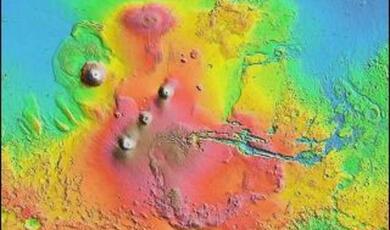A New Sky
Share
- Details
- Text
- Audio
- Downloads
- Extra Reading
The JWST is the most expensive and powerful telescope astronomers have ever constructed. Its launch in 2021 started a new phase in our exploration of the cosmos, with the observatory's golden mirrors producing instantly iconic images of the Solar System's giant planets, nearby star-forming regions and galaxies, and our distant universe.
The lecture includes the latest news from its studies of the early universe, a place lit up by what appears to have been a much more spectacular burst of activity than anyone expected.
Download Text
A New Sky
Professor Chris Lintott
Wednesday 28th May 2025, 7pm – Conway Hall
About a fortnight ago, a team of astronomers led by Rohan Naidu at MIT announced the discovery of what seems to be the most distant galaxy yet discovered. The system, known as MoM-z14, is so far away that we are seeing light emitted just 280 million years after the Big Bang. Its presence is unexpected enough that the researchers, tongues only slightly in cheeks, call it ‘A Cosmic Miracle’.
This lecture explores what we know about this newly found galaxy and its neighbours, what they have to tell us about the evolution of the Universe that we find ourselves in, and celebrates the remarkable telescope – JWST – that makes observations like these possible. JWST was launched on Christmas Day 2021, the largest telescope of its kind ever put into orbit1. Its enormous sunshield to keep its instruments cold2 and beautiful gold coated hexagonal mirrors are designed to reflect infrared light, longer wavelengths suitable for investigating the cold parts of the cosmos where stars and planets form. The light it sees from MoM-z14, by contrast, likely comes from hot, bright, young stars, but the expansion of the Universe in the billions of years since it was emitted has stretched it into the red. What we would normally see in the ultraviolet and visible is, at these distances, rendered into the infrared.
Not all blobs seen shining in the infrared are distant galaxies. MoM-z14 was first spotted in a well-known field through the comparison of images of the field taken in different wavelengths of light by JWST. The object is clearly visible at longer wavelengths but vanishes almost completely at the bluer end of the spectrum; this result makes sense if the object has a spectrum typical of a galaxy with a flat ultraviolet spectrum and a ‘break’ at longer wavelengths. Such a galaxy at very high redshift will have a break that lies within JWST’s filter set, producing the kind of dropout we observe here.
The dropout technique can produce false positives, especially with objects whose spectra do not fit the standard template. The definitive test came with observations made last month, which took not only images but also a spectrum of MoM-z14. The identification of features associated with nitrogen and carbon allow the redshift to be measured, and confirm MoM-z14 as an extremely early galaxy.
Though this is now the record holder, we now know of several systems observed at a similar epoch. The Hubble Space Telescope had found a previous record holder, GNz11, a compact system only 1% of the mass of our Milky Way, forming stars at a prestigious rate. Before MoM-z14, the JWST discovery that attracted the most attentions was JADES-GS-z14-0, one of several found by the relatively small JADES survey. The fact that distant galaxies were being seen in such a small dataset was an early sign that something unexpected was happening; it implied a density of star forming galaxies that was perhaps a hundred times larger than had been predicted.
We had, or so we thought, good predictions of the density of such objects, based on the hierarchical theory of structure formation. This is essentially a fancy way of saying that gravity is all that’s really important in producing the large-scale structure of the Universe. The small fluctuations in density seen in the Cosmic Microwave Background3 are exaggerated by gravity to form galaxies, clusters and superclusters. These then merge to form larger systems, a process we trace via galactic archaeology in the Milky Way4. We can compare the large-scale structure seen in surveys of the local Universe such as the Sloan Digital Sky Survey to hierarchical models produced in supercomputers and, as long as we’re allowed to include the influence of dark matter, be confident that we have a theory that can predict what we see.
But it doesn’t predict the density of bright systems represented by MoM-z14 and JADES-GS-z14-0. So is our grand theory of cosmology, which has resisted all challenges since the late 1990s, wrong?
Maybe. But before we leap to that conclusion, we should look more carefully at the systems that we are finding. What do we know about MoM-z14? Early galaxies seem to fall into two categories – those which are star-like, essentially point sources, and thus are especially compact, and those which are more extended. Some – most notably GNz11 – have central sources which likely reflect bright emission from material falling onto their central black holes. MoM-z14 seems slightly extended, a feature which in the local Universe would suggest a merger between galaxies.
(JWST, with its infrared sensitivity capable of tracing star formation even when it is obscured by dust, has made something of a sport of studying mergers. Stefan’s Quintet, a nearby system of four merging galaxies (and one interloper) was one of the first images released by the telescope team in 2022, and recent work on Arp220 is fascinating).
Another approach assumes that we understand what the stellar population of a distant system like MoM-z14 is like. Locally, we can study the process by which stars form from gas clouds like the ‘cosmic cliffs’ that feature in the most iconic JWST image. Across our galaxy, and its neighbours, it seems that star formation always produces the same mix of stars; specifically, what astronomers call the Initial Mass Function, the distribution of stars of different masses, is universal. If that result holds in the early Universe too, then we can use the brightness and spectrum of MoM-z14 to work out how many stars it holds.
This analysis shows that, like other galaxies seen in the early Universe, it is relatively puny, perhaps the mass of the Large Magellenic Cloud, a system a tenth of the size of the Milky Way, which is devouring it. What’s more, we can play with models of different patterns of star formation, comparing, say, a smooth and constant level of production to something more bursty. The latter seems a better fit to what we’re seeing in MoM-z14, suggesting that we might be catching a galaxy in a state of transition, seeing only those which are at their brightest. It’s also possible that star formation in the unusual conditions of the early Universe, where the gas is enriched only lightly with elements heavier than hydrogen and helium, is more efficient than it is today, which might account for the greater than expected number of visible systems.
Whatever else is happening, it’s clear that MoM-z14 has plenty of fuel for star formation. It has substantial reservoirs of gas, which, judging by the spectrum, seem to be rich in nitrogen when compared to elements such as carbon. As elements such as these are all produced in previous generations of stars, their relative abundance can act as a fingerprint. A similar pattern is seen in the Milky Way’s globular clusters, old cities of stars which must have formed in the early Universe. These may be the local analogues of what we’re seeing now, for the first time, in JWST’s views of distant galaxies.
So are we seeing efficient cluster formation? The peak moments of a firework display of bursty star formation? Or is something missing from our cosmological model? We don’t know – yet. One complicating factor is that each of the galaxies that we’ve studied in detail in the early Universe appears to have its own story to tell, with different shapes, structures, and enrichment of gas common. Luckily, those golden mirrors have more work to do: we are three years into what should be a twenty-year mission of JWST. The telescope’s ability to take deep images of the sky, and to follow up the strange objects we find there, is unrivalled, and will keep a generation of astronomers busy as we try and solve the riddles posed by objects such as MoM-z14.
In this year’s lectures, I’ve tried to highlight the latest results produced by some of the largest and most complicated machines ever built, from missions to asteroids or to the surface of the Sun to Gaia, our celestial cartographer, and from the complexity of LIGO to the exploits of Hubble and JWST, our two greatest space telescopes. In doing so, I hope I’ve shown both that science is not a closed book, but rather is still advancing step by step, measurement by measurement and image by image. I also hope I’ve shown that it’s an endeavour carried out by teams, not by great individuals: at a time when support for the kind of pure science described here, and for the international collaboration spanning continents that makes it possible, is under attack, particularly from ignorant ideologues in the US, I hope I’ve inspired you with stories of what is possible when we decide to pay attention to our beautiful and occasionally confounding Universe.
References
MoM-z14 is described in a paper by Naidu et al, under review at the Open Journal of Astrophysics but available here: https://arxiv.org/abs/2505.11263
An overview of the JWST project – and its trials and tribulations – accompanied by high quality documentary photography is given in ‘Inside the Star Factory: The Creation of the James Webb Space Telescope, NASA's Largest and Most Powerful Space Observatory’, Gunn & Wanjek, 2023, MIT Press
The state of our knowledge before JWST is given by one of the astronomers who has been leading the observations in 'Galaxy Formation and Reionization: Key Unknowns and Expected Breakthroughs by the James Webb Space Telescope’, Robertson, 2022, Annual Review of Astronomy and Astrophysics: https://doi.org/10.1146/annurev-astro-120221-044656
A good explanation of the dropout technique used to identify MoM-z14 is here: https://astrobites.org/2016/09/08/now-you-see-them-now-you-dont/
A recent broad review of observations of early galaxies by JWST is Stark et al, https://arxiv.org/abs/2501.17078
Previous record holder GNz11 as observed by JWST: ‘JADES NIRSpec Spectroscopy of GN-z11: Lyman-α emission and possible enhanced nitrogen abundance in a z=10.60 luminous galaxy’, Bunker et al., 2023, Astronomy & Astrophysics, 677, 88 https://arxiv.org/abs/2302.07256
JADES-GS-z14-0 is in ‘"Spectroscopic confirmation of two luminous galaxies at a redshift of 14"’, Nature, 2024, 633 (8029), 318 https://arxiv.org/abs/2405.18485
Amongst the best known of large hierarchical simulations is IllustrisTNG – explore its archive here: https://www.tng-project.org
For an example of JWST studies of nearby mergers, try this: ‘JWST/NIRSpec insights into the circumnuclear region of Arp 220: A detailed kinematic study’, Ulivi et al., 2025, A&A, 693, A36 https://www.aanda.org/articles/aa/full_html/2025/01/aa51442-24/aa51442-24.html
And for star formation, try ‘Deep diving off the `Cosmic Cliffs': previously hidden outflows in NGC 3324 revealed by JWST’, Reiter et al, Monthly Notices of the Royal Astronomical Society, 2022, 517, 4, 5382 https://arxiv.org/abs/2210.01101
JWST observations of globular cluster M92: https://webbtelescope.org/contents/early-highlights/webb-observes-a-globular-cluster-sparkling-with-separate-star
Part of:
This event was on Wed, 28 May 2025
Support Gresham
Gresham College has offered an outstanding education to the public free of charge for over 400 years. Today, Gresham College plays an important role in fostering a love of learning and a greater understanding of ourselves and the world around us. Your donation will help to widen our reach and to broaden our audience, allowing more people to benefit from a high-quality education from some of the brightest minds.


 Login
Login








